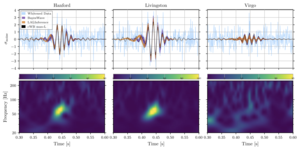Gravity Spy
Script error: No such module "Draft topics".
Script error: No such module "AfC topic".
Type of site | Volunteer Scientific Project |
|---|---|
| Available in | English |
| Owner | Gravity Spy Team |
| Created by | Gravity Spy Team |
| Website | www |
| Commercial | No |
| Registration | Optional |
| Launched | 12 October 2016 |
| Current status | Ongoing |
Gravity Spy is a Zooniverse citizen science project in which volunteers classify data from the LIGO and Virgo gravitational-wave observatories to help scientists train machine-learning algorithms to identify noise sources known as glitches and eliminate them.[1][2][3][4][5] It was launched by a team of LIGO researchers from the Center for Interdisciplinary Exploration and Research in Astronomy (CIERA) and machine-learning experts from the Northwestern University, researchers at CalTech, crowd-sourced science researchers at Syracuse University and Zooniverse web developers.[6][5]
History[edit]
After the beta-testing stage, the project was launched as an official Zooniverse project on 12 October 2016.[7][3]

Gravity Spy 2.0[edit]
On 5 October 2021, the Gravity Spy team were awarded a three-year research grant by the National Science Foundation (NSF) to continue with the next phase of Gravity Spy, Gravity Spy 2.0. The primary goal of the project will be to identify the causes of glitches by searching for correlations between glitches in the main and auxiliary channels. The team also plans to create Beginner, Intermediate, and Advanced workflows that support different modes of interaction at each stage, similar to the workflow system in Gravity Spy.
Non-Gravity Spy Project: GWitchHunters[edit]
On 16 November 2021, a project called GWitchHunters was launched in the Zooniverse by a separate team of researchers from the Virgo Collaboration and the Research Infrastructures for Citizens in Europe (REINFORCE) under a grant by the Community Research and Development Information Service (CORDIS) of the European Commission.[8][9] Within a few weeks, more than 1,500 volunteers participated in the project, and 100,000 image classifications were completed.[10]
Literature[edit]
- Gravity Spy: Integrating Advanced LIGO Detector Characterization, Machine Learning, and Citizen Science
- Deep multi-view models for glitch classification
- Gravity Spy: Humans, machines and the future of citizen science
- Blending machine and human learning processes
- Recruiting messages matter: Message strategies to attract citizen scientists
- Machine learning for Gravity Spy: Glitch classification and dataset.
- Folksonomies to support coordination and coordination of folksonomies.
- Appealing to different motivations in a message to recruit citizen scientists: results of a field experiment
- Did they login? Patterns of anonymous contributions to online communities
- DIRECT: Deep DIscRiminative Embedding for ClusTering of LIGO Data
- Scaffolding training with machine learning: An experiment on participant learning in an on-line production community
- Discovering features in gravitational-wave data through detector characterization, citizen science and machine learning
- Shifting Forms of Engagement: Volunteer Learning in Online Citizen Science. Proceedings of the ACM on Human-Computer Interaction
See Also[edit]
Zooniverse Projects:
- Backyard Worlds: Planet 9
- Disk Detective
- Galaxy Zoo
- Old Weather
- Planet Hunters
- SETILive
- The Milky Way Project
References[edit]
- ↑ Arndt, James (2019-02-27). "Search for Gravitational Waves With 'Gravity Spy' Citizen Science Project". NASA. Retrieved 2022-07-12.
- ↑ Himanshu (2020-07-15). "Gravity Spy : Where Citizen Scientists Hunt For Gravitational Waves". Steamdaily. Retrieved 2022-07-12.
- ↑ 3.0 3.1 "368 | CitizenScience.gov". www.citizenscience.gov. Retrieved 2022-07-12.
- ↑ "'Dancing' black holes yield stellar object as massive as 49 suns". PBS NewsHour. 2017-06-01. Retrieved 2022-08-25.
- ↑ 5.0 5.1 "Researchers turn to "citizen scientists" for help identifying gravitational waves". The University of Alabama in Huntsville. 11 January 2017. Retrieved 2023-02-20.
- ↑ "Gravity Spy: The New Gravitational-Wave Project Using Citizen Science". Center for Interdisciplinary Exploration and Research in Astrophysics (CIERA). 2016-10-14. Retrieved 2022-07-12.
- ↑ "LIGO Launches "Gravity Spy" Citizen Science Program". LIGO Lab | Caltech. Retrieved 2023-02-20.
- ↑ "REsearch INfrastructures FOR Citizens in Europe | REINFORCE Project | Fact Sheet | H2020 | CORDIS | European Commission".
- ↑ "GWitchHunters :: Project Delve". projectdelve.com. Retrieved 2022-07-12.
- ↑ ildenaro.it (2022-02-02). "Spazio, tutti a caccia di onde gravitazionali: debutta la nuova App "GWitchHunters"". Ildenaro.it (in italiano). Retrieved 2023-02-20.
External Links[edit]
This article "Gravity Spy" is from Wikipedia. The list of its authors can be seen in its historical and/or the page Edithistory:Gravity Spy. Articles copied from Draft Namespace on Wikipedia could be seen on the Draft Namespace of Wikipedia and not main one.
